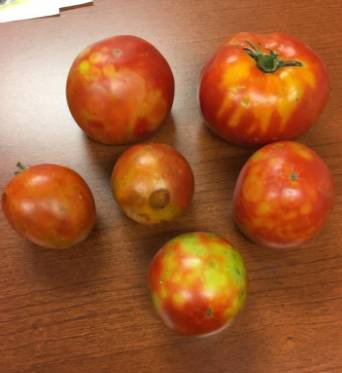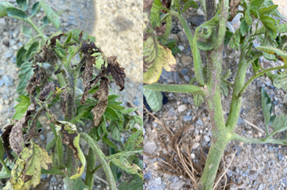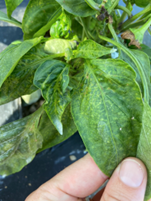Tomato Spotted Wilt Virus

This week’s question is one I have found once before when I worked in North Dakota. While uncommon, this virus can cause significant crop losses for commercial growers and a complete crop failure for homeowners. Tomato Spotted Wilt Virus (TSWV) is one virus worth knowing. With the number of pests and pathogens posing challenges to crop production, the threat of viruses can easily take the back burner. However, viruses can cause irreversible damage and significant crop loss, especially when not identified early and contained.
TSWV is a well-known virus in other regions of the country. In the state of Georgia, for example, it is estimated to cause approximately $9 million in losses in tomato and pepper crops each year, and growers on the West Coast have reported losing up to 50% of tomato plants to the virus. TSWV is often introduced on asymptomatic plants and then spreads to vegetable seedlings or other plants started by seed. One of the primary paths of introduction is through vegetatively propagated ornamental plant material. Still, many weed species that grow under benches and outside high tunnels and greenhouses can also introduce the virus. These include (but are not limited to) dandelion, lambs’ quarters, purslane, shepherd’s purse, and white clover. TSWV has an extensive host range of many hundreds of plant species, including chrysanthemums, petunias, impatiens, nasturtium, begonia, tomato, pepper, eggplant, potato, lettuce, spinach, cucurbits, beans, and more.
Symptoms of the virus differ substantially depending on the plant species infected. Still, they can include stunting, necrotic spots on the leaves and stems, necrotic spots that progress into the death of petioles and growing tips, wilting or cupping of leaves, leaf discoloration (including a bronzing on the top of leaves), concentric rings and spots on leaves and fruit, and petals with spots and/or line patterns. Some symptoms can mimic those caused by bacterial and fungal pathogens or chemical injury. The photo above shows some possible symptoms on the fruit of the tomato.
include stunting, necrotic spots on the leaves and stems, necrotic spots that progress into the death of petioles and growing tips, wilting or cupping of leaves, leaf discoloration (including a bronzing on the top of leaves), concentric rings and spots on leaves and fruit, and petals with spots and/or line patterns. Some symptoms can mimic those caused by bacterial and fungal pathogens or chemical injury. The photo above shows some possible symptoms on the fruit of the tomato.
Thrips spread TSWV. While multiple species can carry and even spread the virus, the Western Flower Thrips (Frankliniella occidentalis) is considered the most (and perhaps only) efficient transmitter. The virus is persistent in the thrips, meaning it remains in the pest and can be spread by the thrips for its entire life. However, females do not pass TSWV onto their progeny, so each generation of thrips must reacquire the virus from infected plant material.
 To prevent and control the spread of TSWV, a mixture of physical, cultural, and chemical control measures may need to be taken. If infected material is present, TSWV cannot spread in plant populations if thrips are absent. Thus, the most obvious way to prevent the virus is to keep the thrips population under control. Control weeds in and around greenhouses and fields. Weeds can harbor and introduce TSWV (especially after an outbreak). They can also serve as a habitat for thrips. Purchase tolerant or resistant varieties when possible. For tomatoes and peppers, seek out varieties with the Sw-5b and Tsw genes, respectively. Resistance should be indicated in seed catalogues. Once a plant has been infected, there is no cure, and it needs to be removed to prevent infection of the entire garden.
To prevent and control the spread of TSWV, a mixture of physical, cultural, and chemical control measures may need to be taken. If infected material is present, TSWV cannot spread in plant populations if thrips are absent. Thus, the most obvious way to prevent the virus is to keep the thrips population under control. Control weeds in and around greenhouses and fields. Weeds can harbor and introduce TSWV (especially after an outbreak). They can also serve as a habitat for thrips. Purchase tolerant or resistant varieties when possible. For tomatoes and peppers, seek out varieties with the Sw-5b and Tsw genes, respectively. Resistance should be indicated in seed catalogues. Once a plant has been infected, there is no cure, and it needs to be removed to prevent infection of the entire garden.

Have questions? Contact our office where our Horticulture Extension Agent will assist you with questions.
Phone: (316) 321-9660
Email: callae@ksu.edu